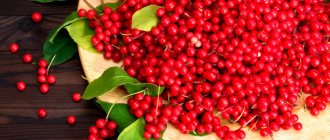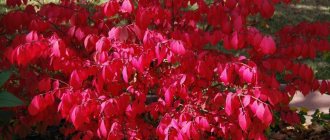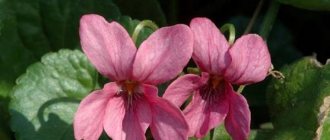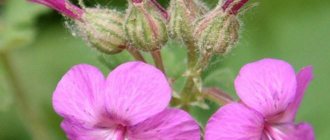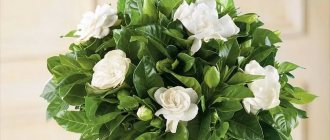Author: Elena N. https://floristics.info/ru/index.php?option=com_contact&view=contact&id=19 Category: Fruit and berry plants Published: August 18, 2017Last edits: November 02, 2020
- Growing conditions
- Growing from seeds
- Medicinal properties
Chinese lemongrass (lat. Schisandra chinensis) is a species of the genus Schisandra chinensis of the Schisandra family, found in the wild on the edges and clearings of coniferous-deciduous and deciduous forests, in narrow valleys of streams and mountain rivers, in old burnt-out areas and clearings in Korea, Japan, China and Russia. territories of the Far East. It grows in groups, forming thickets and rising into the mountains to a height of up to 600 m above sea level. Schisandra chinensis has been cultivated for a very long time: it began to be cultivated for medicinal purposes at least 250 years BC.
Planting and caring for Schisandra chinensis
- Flowering: from the fifth to sixth year of life in late May or early July. Flowering lasts about two weeks.
- Planting: in October or late April-early May.
- Lighting: bright sunlight or partial shade.
- Soil: light, rich in humus, moderately moist and drained.
- Watering: frequent and abundant: 6-7 buckets of water are poured under each bush.
- Fertilizing: from the third season, once every 2-3 weeks, organic fertilizer is applied to the tree trunk circle - a solution of chicken manure or mullein. The tree trunk space is mulched with a layer of humus or leaf compost. In autumn, 20 g of superphosphate and 100 g of wood ash are embedded into the soil under each plant to a depth of 10 cm.
- Garter: the trellis on which this vine is grown is installed immediately after planting. When the vine is located near the wall of the building, it is let down a ladder installed obliquely to the wall.
- Pruning: from the third year after planting, formative pruning begins, which is carried out in the fall, after leaf fall. Unnecessary root shoots are also removed.
- Reproduction: seeds, root cuttings and shoots.
- Pests: not affected.
- Diseases: powdery mildew, ramularia, ascochyta and fusarium.
- Properties: is a valuable medicinal plant.
Read more about growing Schisandra chinensis below.
Trimming
Schisandra begins to be pruned 2-3 years after planting. By this time, the increased growth of the roots is replaced by the rapid development of the above-ground part. Of the numerous shoots that appear, 3-6 are left, the rest are removed at soil level. In adult plants, unproductive branches at the age of 15-18 years are cut out and replaced with young ones selected from the shoots.
It is better to prune lemongrass in the fall, after leaf fall. If the vine is very thickened, then pruning can be done in June-July.
At the end of spring and winter, vines are not pruned, because after pruning there is abundant sap release (crying of the vine) and drying out of the plants. Only root shoots can be removed in the spring, and this must be done annually. Cut out root shoots below soil level.
When sanitary pruning, first of all, dried, broken and small branches that thicken the crown are removed. Long side shoots are shortened in a timely manner, leaving 10-12 buds.
Botanical description
The plant is a climbing deciduous vine up to 15 m long with a trunk up to 2.5 cm in diameter and shoots covered with brown-brown bark, flaky on old ones, and shiny and smooth on young ones. Both the shoots and leaves of lemongrass have a characteristic citrus aroma, from which the plant gets its name.
The leaves of Schisandra are dense, obovate or elliptical, with a wedge-shaped base and a few and indistinct teeth along the edges. The leaves are connected to the shoots by pink or red petioles up to 3 cm long. In spring and summer, the upper part of the leaf blade is light green, shiny, bare, and the lower part is bluish, with pubescence along the veins. In autumn, the leaves of Schisandra chinensis turn yellow-orange and ocher-yellow.
Growing lemongrass: planting and care in open ground
Fragrant, waxy white dioecious flowers up to 2 cm in diameter on drooping pedicels are located in groups of 3-5 in the leaf axils. The aggregate racemose fruit, up to 10 cm long, consists of edible spherical two-seeded berries of red color and sour taste. The berries of Chinese lemongrass also have a characteristic smell of the plant. The kidney-shaped seeds of Schisandra chinensis remain viable only until spring.
- Raspberries: diseases and pests and their control
Planting Schisandra chinensis
When to plant
Growing and caring for Schisandra chinensis is carried out not only for medicinal purposes, but also for decorating the site, since the plant has high decorative qualities. In areas with a warm, mild climate, lemongrass is planted in October, and in the middle zone, planting is carried out at the end of April or beginning of May. Professionals recommend planting at least three plants at a distance of 1 m from each other. If you want to grow a vine near the house, step back 1-1.5 m from the wall so that water from the roof does not drip onto the lemongrass.
How to plant
Schisandra prefers light, but humus-rich, moist and well-drained soil. The plant is shade-tolerant, but will develop better in a well-lit place.
Two- to three-year-old seedlings are used as planting material, which, with a shoot height of only 10-15 cm, have a well-developed root system. Before planting, taller shoots of the seedling are shortened to 3 buds, and the roots are trimmed to 20-25 cm.
A planting hole for Schisandra chinensis is dug with a diameter of 60-70 cm and a depth of at least 40 cm. A drainage layer of expanded clay, broken brick or crushed stone 10 cm thick is laid on the bottom, and to fill the hole a soil mixture is prepared from equal parts of humus, leaf compost and turf earth, adding 200 g of superphosphate, half a kilogram of wood ash and mixing thoroughly. Before planting, pour the soil mixture onto the drainage layer.
Dip the roots of the seedling into a clay mash, add 1 liter of mullein to a bucket, and place the plant on a mound so that its root collar is at surface level after planting. Spread the lemongrass roots and fill the hole with prepared fertile soil. Then compact the soil in the tree trunk circle and water it generously, and when the water is absorbed, fill the root hole with humus or peat. Chinese lemongrass seedlings take root very quickly, but it is advisable to initially protect them from bright sun, provide regular watering and evening spraying in dry weather.
Caring for Schisandra chinensis
Growing conditions
Planting Schisandra chinensis and caring for it is not labor-intensive and will not take up much of your time. The main care measures are watering, loosening the soil, removing weeds, fertilizing, spraying in prolonged dry heat and pruning.
During the growing season, lemongrass is watered frequently and abundantly: 6-7 buckets of water are poured under the plant at a time. The next day after moisture or rain, you need to loosen the soil around the vine and remove weeds. Do not neglect evening spraying of Chinese lemongrass in the heat. Young vines especially need this procedure. To prevent the rapid evaporation of moisture from the soil, it is better to always keep the tree trunk under mulch made of organic material.
They begin to feed Chinese lemongrass from the third year of life: during spring and summer, a solution of organic fertilizers - cow (1:10) or chicken (1:20) manure - is added to the soil once every two to three weeks. A good result is obtained by mulching the trunk circle of Schisandra chinensis with humus or leaf compost. After leaf fall, 100 g of wood ash and 20 g of superphosphate are added under each bush, followed by embedding to a depth of about 10 cm with mandatory subsequent watering of the soil in the tree trunk circle.
During the flowering period, fruit-bearing vines are fed with Nitrophoska at the rate of 50 g per m², and after flowering, a bucket of a solution of fermented mullein or bird droppings is poured under the plant. In autumn, 60 g of superphosphate and 30-40 g of potassium sulfate are scattered under the bushes, and once every 2-3 years, compost is poured under each plant to a depth of 6-8 cm at the rate of 4-5 kg per m².
Schisandra chinensis, since it is a vine, is grown on a trellis, which is installed in the year the plant is planted. This arrangement of branches and shoots allows the sun's rays to better illuminate the plant, and this contributes to the formation of larger fruits and an increase in yield. If you grow lemongrass without support, it is unlikely to bear fruit. The trellis is made from pillars of such a height that after digging to a depth of 60 cm they rise above the ground by 2-2.5 m. The distance between the pillars is maintained at about 3 m, and they are connected to each other by three rows of horizontal wire guides, the lower of which is stretched by height of 50 cm from the ground, and the next ones every 70-100 cm. In the first year, the regrown shoots are tied to the lower guide, and in subsequent years - to those located above. The shoots are secured to the support with a fan. For the winter, Chinese lemongrass is not removed from the trellis.
If you plant a vine near the house, then you can use a ladder installed at an angle as a support.
They begin to prune lemongrass in the third year after planting, when the development of its root system gives way to increased shoot growth. Not only the decorative appearance of Schisandra chinensis, but also the quality of its fruiting depends on proper pruning. During the first formative pruning, 3 to 6 of the strongest and correctly positioned shoots are left on the bush - the future skeleton of the plant, and the remaining shoots are cut out at ground level. In the future, pruning of Schisandra chinensis is carried out twice a year: in autumn and summer. In the fall, after all the leaves have fallen from the plant, cut out weak, diseased, improperly growing and dried shoots that formed over the summer. The part of the vine that has been actively bearing fruit for the last three years should also be removed. This is done so that young shoots of the vine can develop and produce a harvest.
In summer, lemongrass is pruned only if the plant has formed too many young shoots. Professionals advise cutting branches 10-12 buds from the edge. In addition, it is necessary to combat root shoots annually, as well as regularly replace old skeletal branches with new strong shoots from the basal shoots.
- Description of growing and caring for blackberries (video)
Pests and diseases
Schisandra has good immunity and, subject to agricultural practices and good care, is very rarely affected by diseases. It is also resistant to pests. However, if you receive infected planting material, you need to be prepared to deal with diseases. Most often, lemongrass is affected by spotting, powdery mildew and Fusarium wilt.
Among the spots, Schisandra chinensis is affected by ramularia and ascochyta blight. Brown blurry spots and edges on the leaves are the main signs of these diseases. Black dots called fungal pycnidia may appear on the underside of the leaf blade. Diseased leaves should be removed and burned, and the vine should be treated with one percent Bordeaux mixture or another copper-based fungicide.
Powdery mildew covers the leaves and stems of the plant with a sloppy whitish coating. As a result of the development of the disease, lemongrass leaves fall off prematurely. Powdery mildew also affects shoots, buds and roots of Schisandra chinensis. If its symptoms are detected, all affected leaves should be removed, and the plant should be treated with sulfur powder and soda ash solution until the vine recovers. Intervals between treatments are 7-10 days.
Fusarium can affect Schisandra at any age, but more often this problem happens to young plants. The cause of the disease is usually infection of planting material. Wilting is manifested by the formation of rotting areas on the root collar and roots of the plant. The stems of lemongrass darken, become thinner, the leaves turn yellow and fall off, and the vine dies from blockage of blood vessels. It is impossible to cure Chinese Schisandra from Fusarium, but it is quite possible to prevent the development of the disease if the seeds and seedlings are treated with a fungicide solution and the soil with Trichodermin before sowing and planting. If the plant does become sick, it will have to be removed and burned, and healthy bushes, before they become infected, should be treated with a solution of potassium permanganate.
Schisandra chinensis in the Moscow region
Schisandra chinensis has long been common in the Moscow region, as is Schisandra chinensis in the Urals, since the plant normally tolerates even harsh winters down to -35 ºC, and the decorative and medicinal qualities of this crop, as well as its ease of care, make the Far Eastern liana increasingly popular among gardeners. lovers. In the middle zone, Chinese lemongrass does not need to be laid on the ground or covered for the winter; only young plants need protection from the cold, and then only in the first winter. But in the conditions of Siberian frosts, the lashes are carefully removed from the trellis, placed on a bed of spruce branches or straw and generously sprinkled on top with leaves, straw or covered with spruce branches.
Protection from diseases and pests
Schisandra chinensis has a fairly strong immune system. Diseases that rarely appear in plants:
- spotting (ramularia and ascochyta);
- powdery mildew;
- fusarium wilt.
If you take care of fruit and ornamental shrubs according to all the rules of agricultural technology, you can avoid problems not only with diseases, but also with the appearance of pests.
The main signs of the disease are:
- blurry brown spots;
- black dots on the inside of the leaf blade;
- asynchronous whitish plaque;
- darkening and thinning of stems;
- premature yellowing and falling of leaves;
- rot on the root collar and vines.
If any signs of disease are detected, the affected areas should be removed
The leaves and vines are removed from the lemongrass and then burned. If the roots and root collar of a crop begin to rot, then the plant is completely uprooted from the ground and disposed of.
If a Chinese plant gets sick with fusarium, then it will no longer be possible to cure it. To exclude the disease, it is necessary to treat the seeds and seedlings with a fungicide solution and the soil with trichodermin before planting. Plants remaining on the site after uprooting a diseased specimen are treated with potassium permanganate.
Propagation of Schisandra chinensis
Schisandra chinensis propagates by seeds, shoots and root cuttings, however, all the properties of the mother plant are preserved only during vegetative propagation.
Growing from seeds
The easiest way is to sow lemongrass seeds in prepared beds before winter, immediately after collecting them. You can sow in the spring, but in this case the seeds are stratified: they are kept in the bottom drawer of the refrigerator for two months. There is a very effective way to prepare seeds for sowing, developed by professionals: they are stored in fruits until January, then washed from the pulp, put in a nylon stocking and placed under constantly flowing water. At home, seeds in a stocking can be kept in the toilet flush tank so that they end up in fresh, clean water after each flush. After four days, the seeds are squeezed out, placed directly in a stocking in a container with wet calcined sand and kept for a month at a temperature of 18-20 ºC, after which the container with the seeds is buried in the snow for stratification. After a month, the seeds are brought into a room with a temperature of 10 ºC and observed: after a week or two they begin to crack, and then they can be sown to a depth of 5 mm in boxes with a mixture of sand and humus in equal parts. The crops are covered with paper and watered daily. Shoots with large cotyledons, similar to cucumber sprouts, will appear in 1-2 weeks. Caring for seedlings consists of protection from direct sunlight, watering and 1-2 treatments with a weak solution of potassium permanganate to prevent blackleg and other fungal diseases. At the stage of development of 3-4 true leaves, the seedlings are planted in larger boxes according to a 5x5 cm pattern, and in early June, after the warmth has finally set in, the hardened Schisandra chinensis seedlings can be planted in open ground in partial shade. The feeding area of one plant is 10x10 cm². Protect the seedlings from too much sun, and with the onset of autumn, cover them with spruce branches or a thick layer of foliage. Schisandra chinensis is planted in a permanent place from seeds at two to three years of age.
Reproduction by shoots
The most effective method of propagation is planting shoots. The liana is literally surrounded by many shoots on which dormant buds are located. The offspring are separated from the bush and immediately transplanted to a permanent place. In the southern regions, this can be done before the start of sap flow and after leaf fall, and in the northern regions - only in early spring.
Propagation of lemongrass by root cuttings
From the rhizome, cut pieces of roots from 5 to 10 cm long with several dormant buds and, to prevent the overgrown roots from drying out, immediately sprinkle the pieces with damp soil or cover them with a wet napkin. Then the root cuttings are planted in a garden bed or in a cold greenhouse according to a 10x10 pattern and covered with a layer of fertile soil 2-3 cm thick. Planting care involves regular watering. In the spring of next year, the cuttings that have sprouted are planted in a permanent place.
Medicinal beds
Schisandra chinensis (Schisandra chinensis)
Sometimes lemongrass is grown specifically for tea or medicinal preparations made from the leaves and stems. In this case, the seedlings are planted in three beds. The next year in August, the plants are mowed from the first bed. In the second year, the second bed is mowed, and a year later, the third. During this time, the plants in the first bed grow.
The collected green mass intended for tea is spread on cloth or paper and dried for several days in the shade. Store in paper bags until winter. They drink lemongrass tea to restore strength after physical and mental stress. It raises blood pressure in hypotensive patients and can easily replace coffee. The invigorating effect of tea lasts 6-8 hours, so it is better not to drink it late in the evening.
Read more about the beneficial properties of lemongrass in the articles:
Schisandra chinensis - the berry of vitality
Schisandra chinensis - help from nature
Schisandra: berry of five flavors and spicy leaves
Recipes for using lemongrass: from tincture to tea
Varieties of Schisandra chinensis
Unfortunately, there are not so many varieties of Chinese lemongrass. Currently, the most famous of them are:
- Garden-1 is a self-pollinating, highly productive winter-hardy variety, the branches of which reach a length of 10 m. The fruits of Schisandra chinensis of this variety consist of spherical juicy and sour red berries with the smell of lemon, collected in racemose fruits up to 10 cm long;
- Mountain -hardy and productive variety of medium ripening, relatively resistant to diseases and pests. The fruit up to 9 cm long and weighing up to 13 g consists of 15-17 dark red berries with a bitter-sour taste;
- Volgar is a winter-hardy, drought-resistant, late-ripening lemongrass that is practically not affected by diseases and pests and has a universal purpose. It is a monoecious liana with fruits weighing up to 7.3 g, consisting of 14-15 round red fruits of a sour taste with a resinous aroma;
- Pervonets is a frost-resistant, disease- and pest-resistant medium-ripening variety of Russian selection with carmine-red fruits with juicy bright red flesh, a specific sour taste and lemon aroma;
- Myth is a hybrid variety of unknown origin with medium-length fruits, consisting of 15 red fruits with a pleasant sour taste.
SHELTER FOR WINTER
Young plants, of course, need shelter for the winter. Therefore, lemongrass 1-3 years old is covered. Foliage at least 15 cm thick and spruce branches are placed on top to scare away annoying and insidious rodents. However, adult vines do not provide shelter. They have excellent frost resistance and are not at all afraid of cold.
Use our simple tips and you will see that growing Chinese lemongrass is not at all difficult. Also for you in our online store there are more than 1000 names of ornamental and fruit shrubs and trees.
Inna Orlova
Properties of Schisandra chinensis - harm and benefits
Medicinal properties
For medicinal purposes, the fruits and seeds of the plant are mostly used. The fruits of Schisandra chinensis contain resinous substances, schisandrin, potassium, organic acids (malic, citric and tartaric), vitamins, mineral salts, trace elements copper, iodine, selenium, manganese, iron, zinc, essential oil.
The beneficial properties of this species were known back in Ancient China and the plant was actively used in pharmacology. Today, Schisandra chinensis is grown on an industrial scale. The berries of the plant have the ability to tone and stimulate the nervous system, which is why Nanai hunters take a handful of dried fruits with them when setting off on their journey. And not so long ago, tests involving military personnel and athletes showed that Schisandra has the property of relieving fatigue during intense physical exertion: just 2-5 berries of Schisandra chinensis have a stronger effect than phenamine or cola, but, unlike these stimulants, they do not give negative side effects. Schisandra chinensis berries are also indicated for those who engage in intense mental work, and it is very important that their tonic effect does not deplete nerve cells.
Schisandra preparations increase the body's resistance to diseases and adverse environmental influences, stimulate the respiratory system and the functioning of the heart muscle. They are often prescribed for the complex treatment of diseases caused by asthenic and depressive states. It is indicative that as a result of taking Schisandra chinensis preparations there were never any signs of overexcitation.
Fresh lemongrass berry juice can inhibit the development of many pathogens. The high effectiveness of treating chronic gastritis with the seeds of the plant has been proven: even a single dose of powder from the seeds of Schisandra chinensis led to the normalization of gastric acidity in patients suffering from either too high or low levels.
- How to plant fruit trees: prepare the foundation pit correctly
To summarize, we can say that Chinese lemongrass has a positive effect:
- with a general loss of strength;
- with high mental or physical stress;
- with low blood pressure;
- for bronchitis, asthma and tuberculosis;
- with anemia;
- with sexual weakness;
- for diseases of the stomach, kidneys and liver.
Contraindications
Schisandra chinensis, like other medicinal plants, has its own contraindications. You cannot eat its berries, drink its juice or take plant preparations for the following conditions and pathologies:
- vegetative-vascular dystonia;
- allergy;
- epilepsy;
- pregnancy;
- increased excitability;
- arterial hypertension;
- insomnia;
- arachnoiditis;
- increased intracranial pressure;
- acute infectious disease.
Berry picking
The fruits are harvested in September. Their maturity is indicated by their bright red color, softness and transparency. The entire brush is cut off, along with the stalk, which also has medicinal properties. It is also added to teas, which gives the drink a lemon aroma.
Harvesting
Tender lemongrass drupes last only a few days. Then mold grows in them and fermentation of the juice begins. Therefore, the fruits are processed immediately on the day of collection.
Fresh Schisandra chinensis berries
Medicinal properties of Schisandra chinensis
